Written by Eamon Kiernan. July, 2021.
In Demian, Hermann Hesse draws on a wide range of cultural allusions. One of the most recognizable of them is the figure of Beatrice, the heavenly beloved familiar from the works of Dante Alighieri. Less recognisable, because carefully hidden, is what Hesse, through his protagonist, makes of the beloved. Strange as it may seem, Emil Sinclair’s quest for himself, which is the theme and purpose of the novel, requires her symbolic murder.
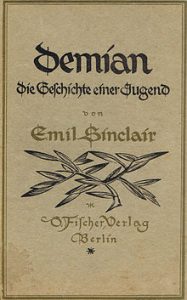
Hesse’s ‘Demian’.
First edition 1919.
The story of Sinclair’s Beatrice is quickly told. Living a degenerate life in a boarding house attached to his school, Emil Sinclair catches a glimpse of a young woman in a nearby park and falls in love with her. Unable to approach her, he never finds out her name, or anything else about her. Because she reminds him of the portrayal of Dante’s beloved in a pre-raphaelite painting, he decides to call her Beatrice.
Inspired by the beauty of Beatrice, Sinclair begins to reform his life. Abandoning the alcohol excesses and the false friends that have been filling his days, he becomes what he calls a ‘servant in a temple’ (Tempeldiener). His daily routines become a setting for secret rituals of adoration of Beatrice. Having discovered that the pre-raphaelite image is not a true enough likeness of his beloved, Sinclair begins to paint her. Painting proves to be a new spiritual gift which becomes a mode of evoking inner guidance. Under the influence of the newly painted image, Sinclair begins to dream again. At the close of the episode, he has one of the most significant dreams of the novel, that of the sparrowhawk breaking out of the world egg. At this point, Beatrice has faded from view.
The moral force which can emerge in erotic attraction has been much praised by poets of different eras and cultures. Perhaps its most elaborate expression in the Western world is found in Dante Alighieri. In Dante’s La Vita Nuova and La Divina Commedia, Beatrice appears as a causal agent of personal transformation and as a reliable guide to the soul on its way to God.
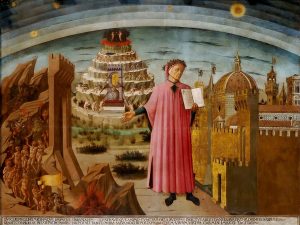
Dante Alighieri
Fresco by Domenico di Michelino
Florence, Santa Maria dei Fiore. Ca. 1465
In Demian, Hesse tells it differently. Sinclair is not on the way to God, but on the way to himself. The image he attempts to make of Beatrice diverges more and more from her perceived reality, and the cultic practice of making the image becomes an end in itself. Eventually, Sinclair gives himself over to the unconscious and accepts the pictorial elements that spontaneously arise before the inner eye. Though the beloved still seems recognisable in the emergent figure, the features of Max Demian are also present in it, as is the vague entity Sinclair refers to as his ‘self’. Now, whenever Sinclair sees Beatrice in the park or on the streets of the town, the strong erotic attraction he used to feel for her has been replaced by ‘a gentle accord’ (ein sanftes Übereinstimmen). The artist’s pen has taken the place of the phallus, and artistic creation has been substituted for love. The body of Beatrice vanishes from Sinclair’s story, and, for a short time, her image comes to dwell in him as his destiny and his soul.
All this is far from innocent. In allowing the ‘gentle accord’ to prevail, Hesse has Sinclair suggest that Beatrice had somehow consented to his acquisition of her image. However, in doing so, Beatrice would also have consented to her effacement and consumption. This is best seen from the incidents surrounding Sinclair’s dream of his heraldic bird, the sparrowhawk. In this dream, which will be discussed in greater detail below, Sinclair is commanded by Max Demian to eat the bird. He awakens to find that his painting of Beatrice has suffered water damage and that her features are no longer recognisable. A parallel is thus set up between Sinclair’s consumption of the heraldic bird and the effacement of Beatrice. When Sinclair decides to redo the damaged painting, it does not occur to him to make a new portrait of Beatrice. He has a new subject: the sparrowhawk.
The alert reader will take note of a scene which occurs before the dream and the water damage when Sinclair stands for the first time before his portrait of the beloved. Well pleased with his work, he decides that it needs a name. As was mentioned, Sinclair did not know the real name of Beatrice. We see here that he would not have cared what her name was, no more than he cared about her features when he painted her. Avoiding any kind of personal name, Sinclair chooses an obscure and portentous motto: Schicksal und Gemüt sind Namen eines Begriffs. Oddly, Hesse allows his protagonist to claim a sudden flash of insight into its meaning, only to renege on an explanation. He also allows him to misattribute its source. Here, one might suspect the presence of an unreliable narrator, or some attempt at irony. In Demian, however, the insistent gravitas of the narrative tone does not allow for the play of alternative meanings. Because the motto has to do with the quest for the self, it is permitted to remain beyond explanation. Through the dual aspect of the protagonist’s utter ignorance and his utter sincerity, the ineffability of his self is asserted without evidence, and its numinous power and transcendental value are placed beyond question.
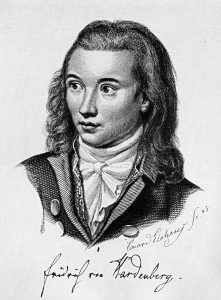
Friedrich von Hardenberg (1772-1801) ‘Novalis’
To some extent, the obfuscation can be cleared up. The motto Sinclair chooses for the painting is a quotation from Heinrich von Ofterdingen, an unfinished novel by the German Romantic poet, Novalis. In the 1842 Owens translation, it is rendered as: “fate and mind are but names of one idea”. [1] Though not incorrect, this translation does not convey the full meaning of the phrase. The connotations of ‘fate’ and ‘mind’ in English differ somewhat from those of ‘Schicksal’ and ‘Gemüt’ in German. Moreover, Hesse’s use of these terms in Demian does not yield a unified meaning.
Often equated with the self Sinclair is seeking and which he could presumably refuse to seek, Schicksal also appears as an external, all-determining power which negates the possibility of free will. Though declaredly individual, and demanding painful solitude from the seeker, Schicksal also takes on a collective guise towards the end of the novel. This is seen most clearly when Sinclair’s story completes itself in the apocalyptic destruction of war. Heralded by the re-appearance of the sparrowhawk, Hesse’s symbol for his protagonist’s self, the destructive impact of war is presented as both freely-chosen and wholly inevitable, and as both an individual and a collective experience, all at once. What seems to be a lack of coherence in the references to Schicksal may be due to an inconclusive grappling with Stoic and Taoist insights on Hesse’s part. The paradox of the individual’s free submission to a pre-existing natural necessity, which is found in Stoicism and Taoism, certainly figures in some of Hesse’s later novels, and perhaps with less confusion.
In his appeal to ‘Gemüt’, Hesse differs from the Romantic master and his antecedents among the German mystics. For Meister Eckart, ‘Gemüt’ signified the coming together of reason, feeling and will. [2] Eckart’s disciple, Johannes Tauler, placed ‘Gemüt’, used with a similar meaning, at the centre of his practice of spiritual counsel. Tauler’s use of ‘Gemüt’ has been well translated as “essential inclination”. [3] In Heinrich von Ofterdingen, ‘Gemüt’ came to designate a fundamental spiritual sense or organ through which the living of life is brought before the creative moral judgment. [4] Here, too, ‘essential inclination’ seems to be an apt rendition. Unlike Eckhart, Tauler and Novalis, Hesse does not place ‘Gemut’ in a primary relationship to a reality external to the self. As indicated by his essay, Eigensinn, which was first published in 1919, the same year as Demian, ‘Gemüt’ is equated with one’s sense of oneself (Eigensinn), which is declared to be a moral virtue of its own [5]. Tauler’s ‘essential inclination’ has become Hesse’s ‘sense of oneself’. ‘Schicksal’ (‘fate’ or ‘destiny’), which can only represent the self as the fulfilment of Sinclair’s life’s quest, corresponds to the inclination towards that same self present in his life from the beginning. When the bewitchment of Hesse’s narration is set aside, the reader is left with two terms for one idea which illuminate neither each other nor the idea.
In Demian, when Sinclair stands before his portrait of Beatrice and applies the motto taken from Novalis, he stands in the sign of a significant new accomplishment: his sense of himself made into his destiny. Given that the essay Eigensinn insists on ascribing heroic qualities to this accomplishment, and given that the portrait is destroyed and replaced by a portrayal of the sparrowhawk, the use of destructive force is revealed as essential to the quest for the self. Symbolically at hand to bear the brunt of Sinclair’s new-found force is Beatrice. As her objective existence is subsumed into his, the image-making capacities of Sinclair’s soul are vitalised, and his quest for himself can take the decisive inward turn already referred to. By his worship of Beatrice, therefore, by the kind of worship he practised, Sinclair readied himself to destroy his beloved. By her destruction, he acquired for his own internal use the energy that she had woken in him and that had sustained her form in his imagination. He has potentiated himself through her symbolic murder.
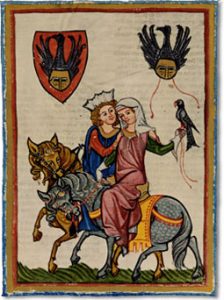
The Minnesinger, Werner von Teuffen, with his lady, who holds a sparrowhawk. Codex Manesse.
Early 14th Century
Evidently, Emil Sinclair’s quest for himself is nothing other than a predation. This is confirmed by the dream of the sparrowhawk, which now takes a central place in the novel. Sinclair’s heraldic bird first appears much earlier, when Max Demian draws his friend’s attention to the coat of arms on the lintel above the doorway of his home. At first, the figure is too indistinct to be made out. It is Demian, using higher intuitive knowledge, who declares it to be a sparrowhawk. A smaller breed of falcon, the sparrowhawk has sometimes figured in medieval courtly poetry. To take a prominent example, Hartmann von Aue’s Erec features a tournament whose prize is a sparrowhawk for the victorious knight to present as a trophy to his lady. A bird for women more than men, the sparrowhawk generally signified the rapprochement of the sexes through the courtly pastime of falconry. [6]
Hesse, who had a strong interest in medieval literarature, well knew that the heraldic bird he had given to Sinclair was an established literary motif, one whose predatory features are not strongly marked. However, when he has Sinclair paint the sparrowhawk, Hesse chooses to make the head of the bird ‘sharp’ and ‘bold’ (scharf, kühn) as it breaks from the world egg. Here, the predatory quality of the sparrowhawk is strengthened. The washed out figure on the coat of arms has become itself. What we see, though, is not the trained companion of a courtly lady, but a rampant bird-of-prey, proudly alone, and eager for the kill.
Demian’s identification of the sparrowhawk on the lintel above Sinclair’s door takes place in the context of his retelling of the Biblical story of Cain and Abel. His interpretation is remarkable for its suspension of the reality of Abel’s murder. Cain’s responsibility for the death of his brother is declared to be an open question and of little importance. Demian holds in focus only the strange sign by which Cain and his descendants are marked out by God as special, all of whom share in an outlaw charisma founded on the mere possibility of being guilty of murder. The emergence of the sparrowhawk at the close of the Beatrice episode cannot but recall Demian’s retelling of the Biblical story and relate the nameless young woman in the park to the fate of Abel, the victim of Cain. Through a framework of murder, cleverly disguised as inspiration, moral transformation and artistic expression, the Beatrice episode unfolds.
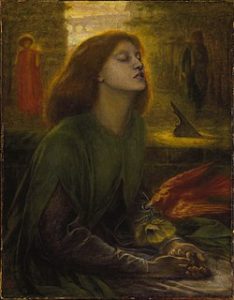
‘Beata Beatrix’
Dante Gabriel Rossetti
As was mentioned, in the use of the figure of Beatrice, Demian acknowledges a debt to the English Pre-Raphaelites. Hesse’s most likely source was the painting Beata Beatrix by Dante Gabriel Rossetti. Again, we can go some way towards clarification. Rossetti’s Beata Beatrix shows a Beatrice transfigured from within and wholly self-contained at the moment of death. She is surrounded by richly symbolic entities which cannot be seen with her eyes and remain mysterious to the observer. For both Rossetti and Hesse, the sacred can be perceived by means of a female form, through which it invites an erotic response. But where Rossetti is concerned with, and achieves, a finished external form, Hesse’s Sinclair welcomes formlessness. Hesse’s use of the pre-raphaelite masterpiece to elevate his protagonist serves both to hide and to valorise a fundamental incapacity for stable form.
Instead of venerating holiness, Emil Sinclair venerates himself. The erotic attraction to a woman becomes the erotic attraction to himself. A sterile narcissism, one might say. It is, in fact, much worse. That clouded mirror in which destiny and the sense of oneself reflect each other ad infinitum lights up with unnatural fertility through the desecration of a woman. To recall Dante’s Divine Comedy, Hesse would have us believe that he is showing us the way to Paradise. But he does not take us further than Hell.
[1] Novalis. Henry of Ofterdingen: A Romance from the German of Novalis (Friedrich von Hardenberg). Cambridge, Mass: Owen, 1842, p. 216.
[2] H. Emmel/Red. “Gemüt”. Historisches Wörterbuch der Philosophie. Hrsg. Joachim Ritter. Band 3 G-H. Wisssenschaftliche Buchgesellschaft Darmstadt, 1974. Clms 260-261.
[3] McGinn, Bernard. The Harvest of Mysticism in Medieval Germany (1300-1500). Vol. 4 of The Presence of God: A History of Western Christian Mysticism. New York, NY, Crossroad, 2005: pp. 251ff.
[4] Emmel, “Gemüt”.
[5] Cf. “Der »Held« ist nicht der gehorsame, brave Bürger und Pflichterfüller. Heldisch kann nur der Einzelne sein, der seinen »eigenen Sinn«, seinen edlen, natürlichen Eigensinn zu seinem Schicksal gemacht hat. »Schicksal und Gemüt sind namen eines Begriffes«, hat Novalis gesagt, einer der tiefsten und unbekanntesten deutschen Geister. aber nur der Held ist es, der den Mut zu seinem Schicksal findet.”
Hesse, Hermann. “Eigensinn” in Entdecke dich selbst! Vom Reiz der Individuation. Herausgegeben von Volker Michels. Frankfurt am Main: Insel Verlag, 2016. 15-34. p. 20.
[6] Heinig, Dorothea. Die Jagd im Parzival Wolframs von Eschenbach. Stellenkommentar und Untersuchungen. PhD thesis. University of Marburg, 2009, p. 58.


